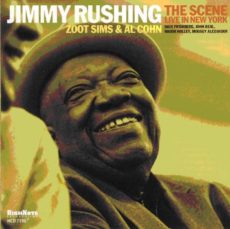
Daily Dose Of Jazz…
James Andrew Rushing was born on August 26, 1901 in Oklahoma City, Oklahoma into a family with musical talent and accomplishments. His father, Andrew, was a trumpeter and his mother, Cora and her brother were singers. He studied music theory with Zelia N. Breaux at Douglass High School, and was unusual among his musical contemporaries, having attended college at Wilberforce University.
Rushing was inspired to pursue music and eventually sing blues by his uncle Wesley Manning and George “Fathead” Thomas of McKinney’s Cotton Pickers. Touring the midWest and California as an itinerant blues singer in 1923 and 1924, he eventually moved to Los Angeles, California, where he played piano and sang with Jelly Roll Morton. He also sang with Billy King before moving on to Page’s Blue Devils in 1927. He, along with other members of the Blue Devils, defected to the Bennie Moten band in 1929.
When Moten died in 1935 Jimmy joined Count Basie for what would be a 13-year tenure. Due to his tutelage under his mentor Moten, he was a proponent of the Kansas City jump blues tradition as heard in his versions of Sent For You Yesterday and Boogie Woogie for the Count Basie Orchestra. After leaving Basie,, as a solo artist and a singing with other bands.
When the Basie band broke up in 1950 he briefly retired, then formed his own group and his recording career soared. He also made a guest appearance with Duke Ellington for the 1959 album Jazz Party. In 1960, he recorded an album with the Dave Brubeck Quartet, known for their cerebral cool jazz sound. Rushing appeared in the 1957 television special Sound of Jazz, singing one of his signature songs I Left My Baby backed by many of his former Basie band compatriots. In 1958 he was among the musicians included in an Esquire magazine photo by Art Kane, later memorialized in the documentary film A Great Day in Harlem.
In 1958 Jimmy toured the UK with Humphrey Lyttelton and his band, appeared in the 1969 Gordon Parks film The Learning Tree, and by 1971 was diagnosed with leukemia, that sidelined his performing career. On June 8, 1972 vocalist Jimmy Rushing, who was known as a blues shouter, balladeer and swing jazz singer, passed away in New York City. He was one of eight jazz and blues legends honored in a set of United States Postal Service stamps issued in 1994. Among his best known recordings are “Going to Chicago” with Basie, and “Harvard Blues”, with a famous saxophone solo by Don Byas.

Miami
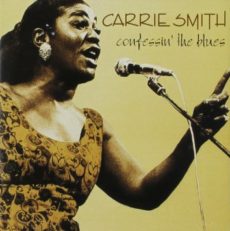
Daily Dose Of Jazz…
Carrie Louise Smith was born August 25, 1925 in Fort Gaines, Georgia. Her mother moved her to Newark, New Jersey to escape an abusive husband but left her to be raised by an older cousin when she joined Father Divine’s church.
Leaving school after the eighth grade, Carrie taught herself to play piano, began singing in church and worked a number of jobs including train announcer at Newark’s train station. She became a member of the Back Home Choir that performed at the 1957 Newport Jazz Festival. She first gained notice singing with Big Tiny Little in the early 1970s, but became internationally known by 1974 when she played Bessie Smith (no relation) in Dick Hyman’s Satchmo Remembered at Carnegie Hall.
This was when Smith launched a solo career, performing with the New York Jazz Repertory Orchestra, with a sextet led by trombonist Tyree Glenn in 1973, Yank Lawson in 1987, and then with the World’s Greatest Jazz Band. In addition to recording numerous solo albums, she starred in the Broadway musical Black and Blue from 1989 to 1991.
Though not well known in the U. S. she had a cult following in Europe and recorded thirteen albums between 1976 and 2002 as a leader. She also recorded with Art Hodes, Buddy Tate, Doc Cheatham, Hank Jones, Winard Harper, Dick Hyman, Clark Terry, Bross Townsend, Bob Cunningham and Bernard Purdie among others over the course of her career.
Jazz and blues vocalist Carrie Smith, lauded by jazz critics Rex Reed, Leonard Feather, Richard Sudhalter and John S. Wilson, passed away of from complications due to cancer at the age of 86 in Englewood, New Jersey on May 20, 2012.
![]()
More Posts: piano
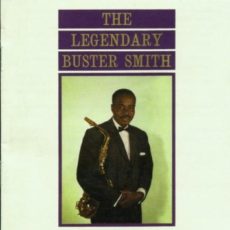
Daily Dose Of Jazz…
Buster Smith was born Henry Smith on August 24, 1904 Alsdorf, Texas, the third boy of five and earned the name “Buster” from his parents as he was an overweight baby when his mother gave birth. His early musical influences were his mother, and his father, who played guitar. At the age of four years, Buster and his brother Boston, a pianist, were playing organ, he played the keys and his brother stepped on the pedals. Soon thereafter, believing it would lead to a life of sin, his grandfather gave away the organ.
In 1919, Smith picked cotton for a week to earn himself the money to buy a $3.50 clarinet. He went on to learn to play several instruments by the time he was eighteen years old. Moving to Dallas in 1922, he joined the Voodie White Trio, playing alto saxophone and clarinet. The following year he began his professional career as an alto saxophonist with the medicine shows, though he had to play very loudly to draw in more customers. This experience defined his musical style, becoming known for being loud.
This period led to Oran “Hot Lips” Page inviting Smith to join his group, the Oklahoma City Blue Devils, in 1925. Over the next few years Buster wrote much of the group’s music, learning from banjo player Johnny Clark, writing lyrics with co-workers from the bank that he worked in.
As a Blue Devils he worked alongside Walter Page, Oran Page, Lester Young, Count Basie, Jimmy Rushing, and Emir “Bucket” Coleman. They toured the Kansas City area and the Midwest, playing jazz for a year, bringing all of its members into prominence. Basie and Page both left the group; and shortly afterwards so did Smith. He and Basie formed the Buster Smith-Count Basie Band of Rhythm, where the two innovated a louder style of jazz. Buster’s contribution to the unique sound was by using a tenor saxophone reed in his alto saxophone to achieve a louder, “fatter” sound. Young opted for a heavier reed, using a baritone saxophone reed on his tenor saxophone. This sound was later labelled the Texas Sax Sound.
Smith gained influence in the Texan music community and industry. He mentored saxophonist Charlie Parker during the 1930s, developing a father-son relationship. He played with a host of musicians including Duke Ellington, Ella Fitzgerald and Earl Hines but in 1941 he returned to Dallas and ceased touring but remained active in the local music scene. In the years that followed he wrote for jazz and blues bands, played often, and known as Professor Smith, taught many young Texan musicians, including Aaron “T-Bone” Walker and Red Garland among others. He also performed session work with Pete Johnson’s Boogie-Woogie Boys, Eddie Durham, Leo “Snub” Mosley, Bon and His Buddies, and the Don Redman Orchestra.
In the 1960s, Smith was involved in auto accident, his injuries causing him to give up the saxophone. Not to be dissuaded from performing he took up the bass guitar, led a dance band and played into the mid-Eighties with the Legendary Revelations. Alto saxophonist Buster Smith, who recorded only one album as a leader in 1959, passed away on August 10, 1991 of a heart attack in Dallas, Texas.
![]()
More Posts: saxophone
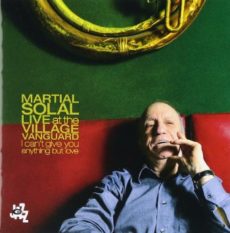
Daily Dose Of Jazz…
Martial Solal was born on August 23, 1927 in Algiers, French Algeria to an opera singer and piano teacher. He began learning the piano from the age of six. After settling in Paris in 1950, he soon began working with leading musicians including Django Reinhardt and expatriates from the United States like Sidney Bechet and Don Byas. He formed a quartet and also occasionally leading a big band in the late that same year.
Martial began his recording career as a leader in 1953 and began composing film music, eventually providing over twenty scores. By 1963 he appeared at the Newport Jazz Festival in Rhode Island but his Newport ’63 is a studio album recreating the live date. His regular trio featured bassist Guy Pedersen and drummer Daniel Humair and from 1968 he regularly performed and recorded with Lee Konitz in the U. S. and Europe.
Throughout his career Solal has performed solo and during 1993-94 he gave thirty solo concerts for French Radio, releasing a 2-CD set Improvise Pour Musique France on the JMS Records label. Solal has also written a piano method book titled Jazz Works.
In addition, pianist Martial has recorded three-dozen albums and worked with Dave Holland, Jack DeJohnette Francois Moutin, Dave Douglas, Gary Peacock, Peter Erskine, Paul Motian, Marc Johnson, Toots Thielemans, John Scofield, Hampton Hawes, Daniel Humair, Niels Pederson, Joachim Kuhn, Hans Koller and Attila Zoller, among others.
In recent years, Martial Solal, who believes music is a language and each performance is a conversation between the participants, has continued to perform and record with his trio.
Sponsored By

Voices From The Community
![]()
More Posts: piano
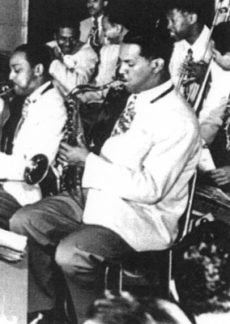
Daily Dose Of Jazz…
Bumps Myers was born Hubert Maxwell Myers on August 22, 1912 in Clarksburg, West Virginia. Influenced by Coleman Hawkins he played the tenor saxophone but also the alto and baritone. Growing up in California he began his musical career at the age of 17 in the Los Angeles area, playing with Curtis Mosby and His Dixieland Blue Blowers,
By 1927 he had recorded for the first time and two years later was playing in Seattle, Washington with Earl Whaley. The mid-1930s saw him with Buck Clayton and Teddy Weatherford, with whom he went on tour. From 1934 to 1936 he lived in Shanghai, China where he worked in Canidrome with Weatherford’s band and Buck Clayton. After returning to the United States in 1937 he played with Lionel Hampton and Les Hite .
The early Forties had Bumps working with the short-lived band of Lee and Lester Young. In 1942 and again in 1945 he worked at Jimmie Lunceford and 1943-48 in Benny Carter’s big band. Mid-1940s he performed several times with Jazz at the Philharmonic and in 1945 he played with Sid Catlett on.
1947 saw him playing with Benny Goodman and recording the hit Call It Stormy Monday (But Tuesday Is Just as Bad). Under his own name he released Bumps Myers & His Frantic Five in 1949 on the Blu, Selective and RPM labels.
In the 1950s, Myers worked as a studio musician, played with Red Callender, and Harry Belafonte in 1958 . After touring with Horace Henderson from 1961-62, Myers retired from music because of issues with his health.
In the field of swing and jazz, he was involved from 1927 to 1960 on some 90 recording sessions with Irving Ashby, Kay Starr, Lee Richardson, Ernestine Anderson, Freddie Slack, Mel Powell, Dan Grissom, Fletcher Henderson, Russell Jacquet, Louis Bellson and Maxwell Davis, Not limiting himself to jazz he also played on a number of rhythm and blues recordings by T-Bone Walker, George Vann, Amos Milburn, Jimmy Witherspoon, Helen Humes, Percy Mayfield, Tony Allen and B. B. King.
Swing saxophonist Bumps Myers, who never gained the notoriety or popularity of his contemporaries, due possibly to working mainly in the Los Angeles music scene, passed away on April 9, 1968 in Los Angeles, California.
![]()
More Posts: saxophone


